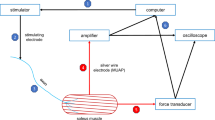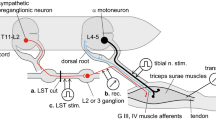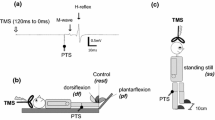Summary
-
1.
The influence of spinal cord and skin temperature on the lengthtension diagrams was tested in 12 lightly anesthetized cats in the following muscles: M. soleus, M. tibialis ant., M. extensor digit. long., and M. gastrocnemius.
-
2.
With lowering the spinal cord temperature the reflex tension of the “rd” M. soleus, mainly innervated by tonic fibres, decreased rapidly, and the length-tension curve paralleled that of the denervated muscle. In the “pale” M. tibialis ant., M. extensor digit. long and M. gastrocnemius, which have a high proportion of phasic innervation, the reflex tension increased to a maximum at extra spinal temperatures between 35° C and 30° C. A further reduction in temperature also decreased the reflex tension in these muscles.
-
3.
Elevation of the spinal temperature above normal body temperature decreased reflex tension in all muscles.
-
4.
In the “pale” muscles, but not in the “red” M. soleus, oscillations of tension became apparent with spinal cord cooling which were synchronous with the cold tremor of the animals. These oscillations were maintained at spinal temperatures at which the reflex tension in the M. soleus was suppressed by the fall in spinal temperature.
-
5.
Peripheral cooling resulted in an increase in tension in all muscles, the peak tension of the length-tension diagrams always being higher than during cooling the spinal cord.
-
6.
The sequence of activation of motoneurons by peripheral cooling was such that the small γ-units were activated first, followed by α-motoneurons of increasing spike size with increasing length of cooling.
-
7.
It is concluded from these experiments that the sensitivity of the spinal motoneurons for a direct thermal stimulation as well as for the indirect thermal stimulus via the thermoreceptors of the skin depends on the size of the cell or some factor correlated with size. The experiments also suggest that the rhythm and the frequency of cold shivering is set by the fast phasic α-motoneurons.
Zusammenfassung
-
1.
In 12 Versuchen an Katzen in leichter Barbituratnarkose wurde der Einfluß der Rückenmarks- und Hauttemperatur auf die Spannungs-Dehnungskurven der folgenden Muskeln untersucht: M. soleus, M. tibialis ant., M. extensor digit. long. und M. gastrocnemius.
-
2.
Die reflektorische Spannungsentwicklung des „roten”, vorwiegend von tonischen Fasern innervierten M. soleus nahm in allen Fällen relativ rasch mit der Senkung der Rückenmarkstemperatur ab, und die Spannungs-Dehnungskurve glich der des denervierten Muskels. Bei den „blassen”, zu einem großen Teil von phasischen Motoneuronen innervierten M. tibialis ant., M. extensor digit. long. und M. gastrocnemius nahm dagegen die Spannungsentwicklung zunächst bis zu einem Maximum bei Extraduraltemperaturen zwischen 35–30° C zu, bei weiter fortschreitender Temperatursenkung jedoch wieder ab.
-
3.
Erhöhung der Rückenmarkstemperatur über die normale Körpertemperatur verminderte die Reflexspannung in allen Muskeln.
-
4.
Bei den „blassen” Muskeln traten während der Rückenmarkskühlung tremorsynchrone Spannungsoscillationen auf, nicht jedoch bei dem „roten” M. soleus. Diese Spannungsoscillationen waren auch noch bei Rückenmarkstemperaturen deutlich vorhanden, bei denen die Spannungsentwicklung im M. soleus bereits völlig durch die Temperatursenkung unterdrückt war.
-
5.
Bei Antrieb der α-Motoneurone durch einen peripheren Kältereiz nahm die Spannung in allen untersuchten Muskeln gegenüber den Ausgangswerten zu und war immer größer als bei zentraler Kühlung.
-
6.
Bei Aktivierung der Motoneurone über die Thermoreceptoren der Haut wurden zuerst die kleinen γ-Motoneurone zu spontaner Aktivität angetrieben und mit zunehmender Kühldauer zunehmend größere α-Einheiten.
-
7.
Diese Versuche bestätigen daher, daß die Empfindlichkeit der Rückenmarksneurone sowohl für einen direkten als auch für einen indirekten über die Thermoreceptoren der Haut wirkenden Temperaturreiz von der Größe der Zelle abhängt, bzw. mit einem mit der Größe der Zelle korrelierten Faktor verbunden ist. Die Ergebnisse legen außerdem den Schluß nahe, daß Rhythmus und Frequenz des Kältetremors im wesentlichen von den schnellen phasischen α-Motoneuronen bestimmt
wird.
Similar content being viewed by others
Literatur
Boyd, I. A.: Differences in the diameter and conduction velocity of motor and fusimotor fibres in nerves to different muscles in the hind limb of the cat. In:D. R. Curtis, andA. K. Mc Intyre (Ed.): Studies in Physiology. Berlin-Heidelberg-New York: Springer 1965.
Buller, A. J., J. C. Eccles, andRosamond M. Eccles: Interactions between motoneurones and muscles in respect of the characteristic speeds of their responses. J. Physiol. (Lond.)150, 417–439 (1960).
Close, R.: Properties of motor units in fast and slow skeletal muscles of the rat. J. Physiol. (Lond.)193, 45–55 (1967).
Eccles, J. C., Rosamond M. Eccles, andA. Lundberg: The action potentials of the alpha motoneurons supplying fast and slow muscles. J. Physiol. (Lond.)142, 275–291 (1958).
—, andC. S. Sherrington: Numbers and contraction-values of individual motor units examined in some muscles of the limb. Proc. roy. Soc. B.106, 326–357 (1930).
Göpfert, H., u.R. Stufler: Die Vorstadien des Kältezitterns bei geringer Abkühlung des Menschen. Pflügers Arch. ges. Physiol.256, 161–180 (1952).
Granit, R., H. D. Henatsch, andG. Steg: Tonic and phasic ventral horn cells differentiated by post-tetanic potentiation in cat extensors. Acta physiol. scand.37, 114–126 (1956).
Granit, R., C. G. Phillips, S. Skoglund, andG. Steg: Differentiation of tonic from phasic alpha ventral horn cells by stretch, pinna and corssed, extensor reflexes. J. Neurophysiol.20, 470–481 (1957).
Hemingway, A.: Shivering. Physiol. Rev.43, 397–422 (1963).
Henneman, E.: Relation between size of neurons and their susceptibility to discharge. Science126, 1345–1347 (1957).
—, andC. B. Olson: Relations between structure and function in the design of skeletal muscle. J. Neurophysiol.28, 581–598 (1965).
—,G. Somjen, andD. O. Carpenter: Functional significance of cell size in spinal motoneurons. J. Neurophysiol.28, 560–580 (1965a).
———: Excitability and inhibitibility of motoneurons of different sizes. J. Neurophysiol.28, 599–620 (1965b).
Kawamura, Y.: Neuromuscular organization of shivering. In:J. S. Hannon andE. Viereck (Ed.): Neural aspects of temperature regulation. Fairbanks Arctic Aeromedical Laboratory 1961.
Kernell, D.: Input resistance electrical excitability, and size of ventral horn cells in cat spinal cord. Science152, 1637–1640 (1966).
Klussmann, F. W.: Der Einfluß der Temperatur auf die afferente und efferente motorische Innervation des Rückenmarks. I. Temperaturabhängigkeit der afferenten und efferenten Spontantätigkeit. Pflügers Arch.305, 295–315 (1969).
— u.M. Kosaka: Kältezittern während isolierter Rückenmarkskühlung bei spinalisierten Tieren. Pflügers Arch. ges. Physiol.279, R23 (1966).
Koizumi, J. Ushiyama, andC. McC. Brooks: Effect of hypothermia on excitability of spinal neurons. J. Neurophysiol.23, 421–431 (1960).
Kosaka, M., u.E. Simon: Der zentralnervöse spinale Mechanismus des Kältezitterns. Pflügers Arch.302, 357–373 (1968).
Kronecker, H., u.W. Stirling: Die Genesis des Tetanus. Arch. Anat. Physiol. Lpz. (Physiol. Abt.)2, 1–40 (1878).
Kuhnke, E.: Über Kältetremor und seine Amplituden-periodik bei der narkotisierten Katze. Pflügers Arch. ges. Physiol.254, 421–429 (1952).
Levy, F.: Recherches expérimentales sur la commande dufrisson thermique chez le chien, voies et centres nerveux au niveau de la moelle épinière. Lyon: Imprimerie Emmanuel Vitte 1963.
Lippold, O. C. J., J. W. T. Redfearn, andJ. Vuco: The influence of afferent and descending pathways on the rhythmical and arrythmical components of muscular activity in man and the anesthetized cat. J. Physiol. (Lond.)146, 1–9 (1959).
McPhedran, A. M., R. B. Wuerker, andE. Henneman: Properties of motor units in a homogeneous red muscle, (soleus) of the cat. J. Neurophysiol.28, 71–84 (1965).
Meurer, K.-A., C. Jessen u.M. Iriki: Kältezittern während isolierter Kühlung des Rückenmarks nach Durchschneidung der Hinterwurzeln. Pflügers Arch. ges. Physiol.293, 236–255 (1967).
Perkins, J. F.: The role of the proprioceptors in shivering. Amer. J. Physiol.145, 264–271 (1945).
Pierau, F.-K., M. R. Klee, andF. W. Klussmann: Analysis of effects, of local hypo- and hyperthermia on mammalian spinal motoneurons. Fed. Proc., Symposium on Altitude and Cold28, 1006–1010 (1969).
—— u.W. Papajewski: Die Wirkung schneller lokaler Kühlung auf die Membraneigenschaften spinaler Motoneuren der Katze. Pflügers Arch. ges. Physiol.300, R 91 (1968).
Ramon y Cajal, S.: Histologie du système nerveux de l'homme et des vertébrés, Bd. 1. Paris: Maloine 1909.
Ranvier, L.: De quelque faits relatifs à l'histologie et à la physiologie des muscles stries. Arch. Physiol. norm. path. Serie 2,7, 5–15 (1874).
Simon, E., F. W. Klussmann, W. Rautenberg u.M. Kosaka: Kältezittern bei narkotisierten spinalen Hunden. Pflügers Arch. ges. Physiol.291, 187–204 (1966).
Spaan, G., u.F. W. Klussmann: Über die Frequenz des Kältezitterns bei Tieren verschiedener Größe. Pflügers Arch. ges. Physiol.300, 42 (1968).
Stelter, W.-J., u.F. W. Klussmann: Der Einfluß der Rückenmarkstemperatur auf die Dehnungsantwort tonischer und phasischer α-Motoneurone. Pflügers Arch.309, 310–327 (1969).
—,G. Spaan, H. Wietelmann u.F. W. Klussmann: Der Einfluß der peripheren und zentralen Temperatur auf die Dehnungsreflexe roter und blasser Muskeln. Pflügers Arch. ges. Physiol.300, R 43 (1968).
Stein, J. M., andH. A. Padykula: Histochemical classification of individual skeletal muscle, fibers of the rat. Amer. J. Anat.110, 103–124 (1962).
Stuart, D. G., E. Eldred, A. Hemingway, andY. Kawamura: Neural regulation of the rhythm of shivering In: Temperature: Its measurement and control in science and industry, Vol. III, Part III, p. 545. New York: Reinhold Publ. 1963.
—, andE. Eldred: The rhythm of shivering. III. Central contributions. Amer. J. phys. Med.45, 91–104 (1966).
Suda, I., K. Koizumi, andC. McC. Brooks: An analysis of effects of hypothermia on central nervous system responses. Amer. J. Physiol.189, 373–380 (1957).
Taylor, A.: The significancer of grouping of motor unit activity. J. Physiol. (Lond.)162, 259–269 (1962).
Wuerker, R. B., A. M. McPhedran, andE. Henneman: Properties of motor units in a heterogeneous pale muscle (M. gastrocnemius) of the cat. J. Neurophysiol.28, 85–99 (1965).
Author information
Authors and Affiliations
Rights and permissions
About this article
Cite this article
Stelter, W.J., Spaan, G. & Klussmann, F.W. Der Einfluß der spinalen und peripheren Temperatur auf die Reflexspannung „roter” und „blasser” Muskeln. Pflugers Arch. 312, 1–17 (1969). https://doi.org/10.1007/BF00586691
Received:
Issue Date:
DOI: https://doi.org/10.1007/BF00586691




